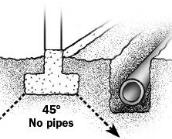 Now
that you understand the natural forces that the foundation must counter,
lets see how this is accomplished.
Now
that you understand the natural forces that the foundation must counter,
lets see how this is accomplished.
First
of all, there are three basic foundation constructions types.
The basement and its smaller cousin called the crawl space.
The concrete slab.
Piles, piers and grade beams. Piles and piers are like a house build on stilts while grade beams are like a pontoon float.
Regardless of the method or type of foundation used, they all start with the footing. The footing is a way to distribute the loads over a larger area and is designed to reduce the chance of movement.
Now
lets throw a curve called a frost line. Frost Line??? Now there's another
issue we haven't reviewed.
To see what the national frost line map looks like, click here-->>
The frost line is the point underground in which below this point, the foundation should no longer be influenced by the moisture in the ground freezing and forcing the foundation to heave upward. Every county in United States has a Building Code frost line requirement. At approximately 6 foot under ground, the earth normally maintains a 55 degree constant temperature. (Not to be morbid, but hence the term 6-feet-under.) But, in different parts of the country, the frost line is located at different depths. The colder the climate, the deeper the frost line.
The footing, as stands to reason, should always be below the frost line. But that brings up another question. Just by the nature of the word "Frost Line", water must be the issue.
When the footing is being prepared, water flow is the main concern to address.
This
is accomplished in two manors.
-
First is the above grade level water from rain, snow and simply watering the yard. The grade is given a negative slope away from the house to prevent water from collecting around the homes foundation, seeping into the ground and later becoming an issue when it freezes.
-
The second is water that stands around the foundation and soaks into the ground. This water is collect through a foundation drainage system called tiles or drain tubes.
Tiles are placed around the perimeter of the foundation and can be placed both inside and outside the footing. There are also a series of tubes which pass from the inside to the outside to help stabilize (or equalize) pressures and moisture.
From this point, things get tricky. But the most important thing for the home owner to know, is the condition of the tile system.
Although you can't see the system once it is graded over, there will be signs of problems like wet or damp basements or cracks in the basement wall. Some cracks are acceptable and are caused by normal settlement of the home. A home inspector can give you an idea as to the degrees of the cracks and may suggest calling in an engineer to review the review the condition or cracks.
(Remember, ONLY a licensed structural engineer can advise you on repairs to structural house components.)
From here we'll go to the foundation construction.
If you think about the reason for a foundation, then you can understand the types of construction. Example: If you live in California where the frost line is 2-4 inches, then a slab works best and is the least expensive. It also allow the home to shift during earth quakes like a large pillow to float on. If you live in Florida where the soil is very sandy, then piers make sense. Or in Ohio where the frost line is 32 inches, a basement or crawl space makes sense, since you have to dig for the footing, why not make it useable space.
All of the general construction will end up putting you at the sill plate - the first layer where the house actually starts becoming a house.